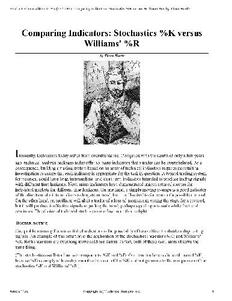
Comparing Indicators: Stochastics %K versus Williams' %R PDF
Preview Comparing Indicators: Stochastics %K versus Williams' %R
Stocks & Commodities V. 9:6 (237-238): Comparing Indicators: Stochastics %K versus Williams' %R by Thom Hartle Comparing Indicators: Stochastics %K versus Williams' %R by Thom Hartle I ronically, technicians today suffer from overabundance. Compared with the dearth of only a few years ago, technical analysis packages today offer so many indicators that a trader can be overwhelmed. As a consequence, building a trading system based on an array of technical indicators requires painstaking investigation to assure that each indicator is appropriate for the task in question. A typical trading system, for instance, could have long, intermediate- and short-term indicators intended to produce trading signals with different time horizons. Now, many indicators have demonstrated unique rates of success for individual markets for different time horizons. On one hand, a simple moving average is a good indicator of the direction of a intermediate- to long-term trend, but it is ill-suited to forewarn of a possible reversal. On the other hand, an oscillator will alert a trader of a loss of momentum setting the stage for a reversal, but it will produce ineffective signals regarding the trend, perhaps signaling reversals while the trend continues. The choice of technical studies can confuse more than enlight. DOUBLE, DOUBLE One problem arising from a surfeit of indicators is the possibility of two different indicators duplicating signals. An example of this situation is the application of the stochastics indicator (%K) and Williams' %R. Both indicators are overbought/oversold oscillators. In fact, both of these oscillators observe the same thing. (The stochastics oscillator has two components: %K and %D. Our concern here is directed toward %K, because %D is simply a three-day smoothed version of the %K and not germane to the comparison of the stochastics %K and Williams' %R.) Article Text Copyright (c) Technical Analysis Inc. 1 Stocks & Commodities V. 9:6 (237-238): Comparing Indicators: Stochastics %K versus Williams' %R by Thom Hartle The formula for the stochastics %K is: (cid:230) C-L (cid:246) %K=100(cid:231) 5 (cid:247) Ł H -L ł 5 5 Where C = Today's close L5 = Lowest low in the last five trading days H5 = Highest high in the last five trading days Here, the value of the current close is compared with the lowest low in the last five trading days. Then the difference between the highest high and lowest low of the last five trading days are determined. These differences form a ratio that reflects a percentage of the closing price in relationship to the trading range of the last five days. This percentage value is then multiplied by 100 to calculate %K. The formula for the %R is: (cid:230) H -C (cid:246) %R=100=(cid:231) 5 (cid:247) Ł H -L ł 5 5 Where C = Today's close L5 = Lowest low in the last five trading days H5 = Highest high in the last five trading days The difference between the ratios determined in the %K and %R are inverse: %K compares the close to the lowest low, while %R compares the close to the highest high. I n this equation, the close is compared with the highest high for the last five trading days. The denominator is the same as in the formula for the stochastics %K, the highest high in the last five trading days minus the lowest low in the last five trading days. The difference between the ratios determined in the %K and %R are inverse: %K compares the close to the lowest low, while %R compares the close to the highest high (Figure 1). The same high-low price range is used for both indicators, and the only difference is that %K compares the close to the low, while %R compares the close to the high. If you use the same n for the lookback period in calculating the two indicators, you should produce the same graphs (Figure 2). Obviously, it's overkill to use both these indicators for one task. You don't need two different technical studies telling you the same thing. Diligent market participants need to look hard at the selected indicators to aid in trading decisions. Each indicator should stand up to scrutiny based on its individual merits. There must be a balance between Article Text Copyright (c) Technical Analysis Inc. 2 Stocks & Commodities V. 9:6 (237-238): Comparing Indicators: Stochastics %K versus Williams' %R by Thom Hartle having too many indicators and not enough. Thom Hartle is the Editor of STOCKS & COMMODITIES. FIGURE 1: Both %K and %R determine where the current close is relative to the recent trading range. The stochastic %K uses the difference between the close and the low, while %R uses the difference between the close and the high. Consequently, the two indicators are the inverse of each other. Figures Copyright (c) Technical Analysis Inc. 3 Stocks & Commodities V. 9:6 (237-238): Comparing Indicators: Stochastics %K versus Williams' %R by Thom Hartle FIGURE 2: The upper chart is the daily bar chart of the June bond contract. The middle chart is the five-day %K and the lower chart is the five-day %R Simple observation demonstrates that the two indicators are the same. (Slight plotting differences are due to computer rounding.) Figures Copyright (c) Technical Analysis Inc. 4
